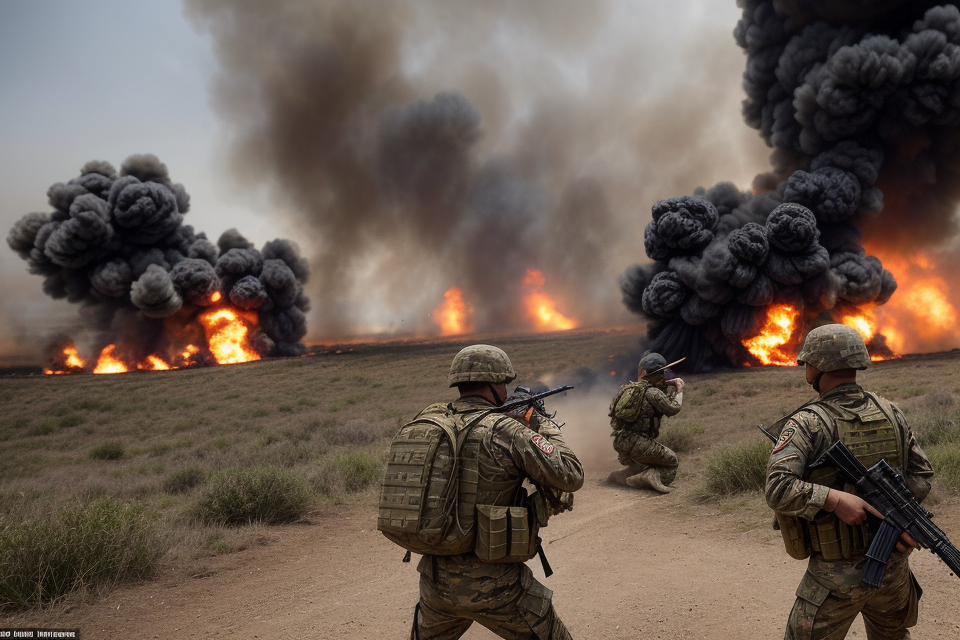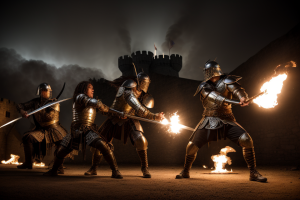
Head-on battle, also known as a direct engagement, is a military strategy where two opposing forces face each other in a straight-up confrontation. This type of battle is often characterized by a high level of intensity and can result in significant casualties on both sides. The term “head-on” is used to describe the way the two forces collide, with each side attempting to defeat the other through brute force. In this article, we will explore what head-on battles mean and how they affect military strategy.
A head-on battle refers to a direct confrontation between two opposing forces, often with the aim of achieving a decisive victory. This type of battle can have significant implications for military strategy, as it often involves large numbers of troops and resources being committed to a single, focused objective. Head-on battles can be risky, as they often result in high casualties, but they can also be effective in achieving a swift and decisive outcome. However, the nature of modern warfare has evolved to include a wide range of tactics and strategies beyond head-on battles, including guerrilla warfare, insurgency, and asymmetric warfare, which can make traditional military strategies less effective.
What is a head-on battle?
Definition and characteristics
A head-on battle, also known as a frontal assault or a direct confrontation, is a military engagement in which two opposing forces confront each other directly, typically with the intention of achieving a decisive victory. This type of battle is characterized by a face-to-face combat and limited maneuverability, as both sides engage in a straightforward, linear approach to combat.
In a head-on battle, the goal is to defeat the enemy’s main force, which often results in high casualties on both sides. The lack of maneuverability means that soldiers are often confined to a specific area, making it difficult to avoid enemy fire or flanking maneuvers.
Despite its risks, head-on battles can be effective in certain situations, such as when a swift victory is needed to achieve a strategic objective or when the enemy’s main force is vulnerable. However, it is essential for military leaders to carefully consider the risks and potential outcomes before deciding to engage in a head-on battle, as it can often result in high casualties and long-term consequences for both sides.
Historical examples
Battle of Gettysburg
The Battle of Gettysburg, fought from July 1 to July 3, 1863, was a pivotal engagement of the American Civil War. The battle was fought in and around the town of Gettysburg, Pennsylvania, and involved Union and Confederate forces. The Confederate army, led by General Robert E. Lee, was attempting to invade the North and defeat the Union army, led by General George Meade. The battle began when the two armies collided on July 1, and continued for two more days, with the Union army ultimately emerging victorious. The battle is often considered a turning point in the Civil War, as it marked the farthest advance of Confederate forces into Union territory.
Somme Offensive
The Somme Offensive was a battle fought during World War I, fought by the Allies, including the British and French armies, against the German army. The battle began on July 1, 1916, and lasted until November 18, 1916. The battle was characterized by a head-on assault by the Allies against the German lines, with little progress made despite heavy losses on both sides. The battle is often remembered as one of the deadliest in history, with an estimated 1 million casualties on both sides.
Battle of Stalingrad
The Battle of Stalingrad was a major engagement of World War II, fought between the German and Soviet armies. The battle was fought in and around the city of Stalingrad, now known as Volgograd, and lasted from August 1942 to February 1943. The battle was characterized by a head-on assault by the Germans against the Soviet defenders, with heavy losses on both sides. The battle ultimately resulted in a Soviet victory, and is often considered a turning point in the war, as it marked the beginning of the Soviet counteroffensive against the Germans.
The importance of head-on battles in military strategy
Tactical considerations
- Enemy strength and position
In military strategy, the tactical considerations of head-on battles are crucial for assessing the enemy’s strength and position. This involves analyzing the enemy’s troop strength, their weapons and equipment, and their deployment and formation. By evaluating these factors, military commanders can determine the enemy’s offensive and defensive capabilities and devise appropriate countermeasures.
- Terrain and weather conditions
Another tactical consideration in head-on battles is the terrain and weather conditions. The type of terrain, such as flat or hilly, urban or rural, can impact the movement and maneuverability of troops and vehicles. Weather conditions, such as rain, snow, or fog, can also affect visibility and mobility, making it more difficult to navigate and aim weapons accurately. Military commanders must take these factors into account when planning and executing head-on battles to ensure that their forces are prepared for any potential challenges.
- Weaponry and technology
Finally, the tactical considerations of head-on battles also involve evaluating the enemy’s weaponry and technology. This includes assessing the enemy’s firepower, such as artillery, aircraft, and missiles, as well as their communication and intelligence capabilities. By understanding the enemy’s technological advantages and disadvantages, military commanders can develop strategies to counter their enemy’s strengths and exploit their weaknesses. Overall, these tactical considerations are essential for determining the outcome of head-on battles and shaping military strategy.
Strategic implications
Resource allocation
In a head-on battle, the opposing forces confront each other directly, often resulting in a fierce and prolonged engagement. The strategic implications of this type of battle extend beyond just military objectives and can have significant effects on resource allocation. Commanders must carefully consider the allocation of resources such as manpower, ammunition, and supplies, as these will be crucial in determining the outcome of the battle. The effective management of resources is critical, as the side that runs out of resources first may be at a significant disadvantage.
Military objectives
Head-on battles can have a profound impact on military objectives. The primary objective of a head-on battle is usually to defeat the enemy’s forces and gain control of the battlefield. This type of battle can also have the objective of wearing down the enemy’s forces, which can set the stage for future engagements. The outcome of a head-on battle can also impact the morale of both sides, as well as the outcome of the overall conflict.
Public opinion and morale
Head-on battles can have a significant impact on public opinion and morale. Battles that are long and brutal can lead to significant losses on both sides, which can impact public opinion and morale. If the public becomes disillusioned with the conflict, it can lead to political instability and even a loss of support for the war effort. On the other hand, a decisive victory in a head-on battle can boost morale and strengthen public support for the war effort.
Overall, the strategic implications of head-on battles are numerous and far-reaching. Commanders must carefully consider the potential impact of a head-on battle on resource allocation, military objectives, and public opinion and morale when deciding on a course of action.
The role of head-on battles in modern warfare
Head-on battles have been a crucial component of military strategy throughout history. In modern warfare, the role of head-on battles has evolved in response to changes in military technology, the rise of guerrilla warfare and asymmetric conflicts, and the emergence of cyber warfare and information operations.
Evolution of military technology
Advancements in military technology have greatly impacted the role of head-on battles in modern warfare. The development of more sophisticated weapons systems, such as aircraft, tanks, and artillery, has enabled armies to engage in more complex and coordinated operations. These technological advancements have also made it possible for military forces to communicate and coordinate more effectively, allowing them to conduct head-on battles on a larger scale.
Guerrilla warfare and asymmetric conflicts
In recent years, the rise of guerrilla warfare and asymmetric conflicts has led to a decline in the importance of head-on battles in military strategy. Asymmetric conflicts involve opposing forces with significantly different levels of military strength, making it difficult for traditional military forces to engage in head-on battles. In these types of conflicts, guerrilla tactics, such as ambushes and sabotage, are often more effective than traditional military operations.
Cyber warfare and information operations
The emergence of cyber warfare and information operations has also changed the role of head-on battles in modern warfare. In today’s world, the use of technology and information is increasingly important in military operations. Cyber warfare involves the use of the internet and other forms of technology to conduct attacks on enemy infrastructure and communications systems. Information operations involve the use of media and propaganda to influence public opinion and shape the information environment. These types of operations can be just as important as traditional military operations in modern warfare.
Overall, the role of head-on battles in modern warfare has evolved in response to changes in military technology, the rise of guerrilla warfare and asymmetric conflicts, and the emergence of cyber warfare and information operations. While head-on battles remain an important component of military strategy, they are no longer the only way to achieve military objectives. Modern military forces must be able to adapt to these changes and incorporate new tactics and technologies into their operations in order to remain effective in today’s complex and ever-changing battlefield environment.
Preparing for head-on battles: Training and Equipment
Physical and mental preparation
In the context of military strategy, physical and mental preparation are crucial for soldiers engaging in head-on battles. This involves ensuring that troops are combat-ready and equipped with the necessary skills and knowledge to carry out their missions effectively.
One aspect of physical preparation is ensuring that soldiers are physically fit and able to withstand the demands of combat. This includes physical training to build strength, endurance, and agility, as well as medical screenings to identify and address any health issues that could impact a soldier’s ability to fight.
Mental preparation is equally important. Soldiers must be trained in maneuver warfare, which involves rapidly moving and positioning troops to gain an advantage over the enemy. This requires strategic thinking and the ability to adapt to changing circumstances on the battlefield.
Counter-insurgency tactics are also essential for soldiers engaging in head-on battles. These tactics involve identifying and neutralizing enemy threats while minimizing casualties among friendly forces. This requires a deep understanding of the local terrain, culture, and the enemy’s tactics and strategies.
Overall, physical and mental preparation are critical components of military strategy, ensuring that soldiers are combat-ready and able to execute their missions effectively in head-on battles.
Technological advancements
Armor and personal protective equipment
Head-on battles often involve intense close-quarters combat, which requires military personnel to have adequate armor and personal protective equipment. Modern military forces have access to advanced armor systems that provide superior protection against a wide range of threats, including bullets, shrapnel, and explosive devices. These armor systems are designed to disperse the impact of incoming threats, reducing the risk of injury or death to the wearer. Additionally, personal protective equipment such as helmets, body armor, and combat boots are essential for soldiers engaging in head-on battles.
Weapons and munitions
The weapons and munitions used in head-on battles play a crucial role in determining the outcome of the conflict. Modern military forces have access to a wide range of advanced weapons systems, including assault rifles, machine guns, grenade launchers, and anti-tank missiles. These weapons are designed to provide superior firepower and accuracy, allowing soldiers to engage targets at longer ranges and with greater precision. Additionally, modern munitions are designed to be more effective against armor and other types of protection, making them more lethal in close-quarters combat.
Intelligence, surveillance, and reconnaissance
Head-on battles often require military forces to have a deep understanding of the battlefield and the enemy’s tactics and movements. Modern military forces have access to advanced intelligence, surveillance, and reconnaissance (ISR) systems that provide real-time situational awareness. These systems include drones, satellite imagery, and ground-based sensors that can detect and track enemy movements, providing critical information to soldiers on the ground. This information can be used to adjust tactics and strategy, improving the chances of success in head-on battles.
The enduring relevance of head-on battles
Adaptation to changing battlefield conditions
In modern warfare, the battlefield is constantly evolving, and the need for flexibility and adaptability has become paramount. Despite the emphasis on non-linear warfare, head-on battles remain relevant due to their ability to provide a clear and decisive outcome. As a result, militaries continue to invest in training and equipment to prepare for these types of engagements.
Preservation of traditional military values
Head-on battles represent a tradition of valor and sacrifice that is deeply ingrained in military culture. For many militaries, the willingness to engage in head-on battles is seen as a demonstration of bravery and determination. As such, head-on battles are still considered a viable and important aspect of military strategy, despite the increasing emphasis on other types of warfare.
Continuity and innovation in military strategy
Militaries around the world are constantly seeking to balance continuity and innovation in their strategic approaches. Head-on battles represent a tradition of combat that has been passed down through generations of soldiers, and the skills and techniques required for these engagements are still taught in military training programs. However, militaries are also investing in new technologies and tactics to ensure that they remain relevant and effective in the face of evolving threats.
FAQs
1. What is a head-on battle?
A head-on battle is a military strategy in which two opposing forces engage each other directly, typically with the intention of achieving a decisive victory. This type of battle is characterized by a straightforward and frontal assault, with little to no flanking or maneuvering.
2. How does head-on battle affect military strategy?
Head-on battles can have significant effects on military strategy, as they often result in high casualties and can be difficult to execute successfully. They require a significant amount of resources, including manpower, weaponry, and ammunition, and can leave forces vulnerable to counterattacks. As a result, many military strategists prefer to use other tactics, such as flanking or encircling, to gain an advantage over their opponents.
3. What are the advantages of a head-on battle?
One advantage of a head-on battle is that it can allow forces to engage their opponents directly and quickly, potentially leading to a decisive victory. Additionally, it can be easier to coordinate and communicate during a head-on battle, as the opposing forces are more likely to be in close proximity to one another.
4. What are the disadvantages of a head-on battle?
One disadvantage of a head-on battle is that it can result in high casualties, as both sides are likely to sustain significant damage. Additionally, it can be difficult to execute successfully, as forces may become disorganized or vulnerable to flanking attacks. Finally, head-on battles can deplete resources, such as manpower, weaponry, and ammunition, making it difficult for forces to continue fighting effectively.
5. When might a military force choose to engage in a head-on battle?
A military force might choose to engage in a head-on battle when they believe that they have a significant advantage in terms of numbers, weaponry, or other resources. They may also choose this tactic when they are attempting to achieve a decisive victory or when they believe that their opponents are vulnerable to a direct assault.







